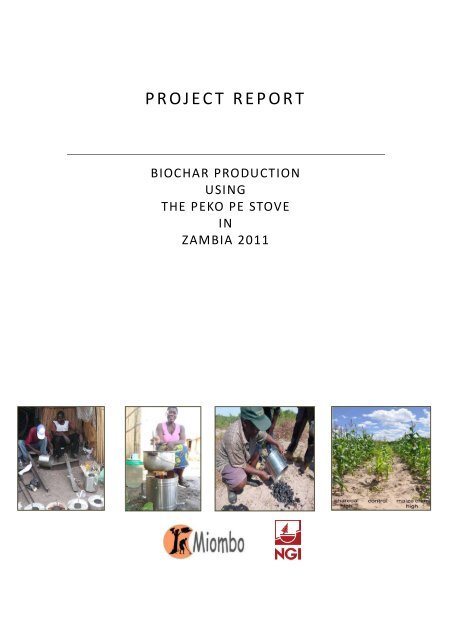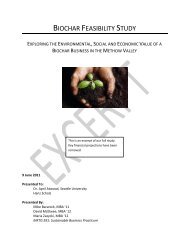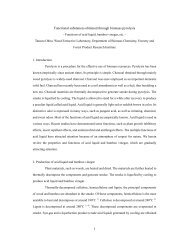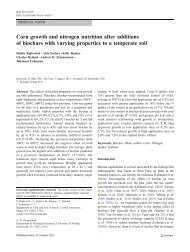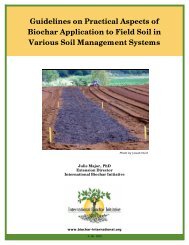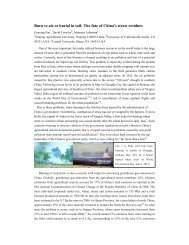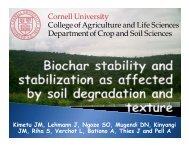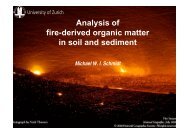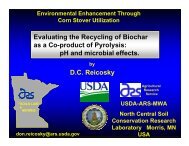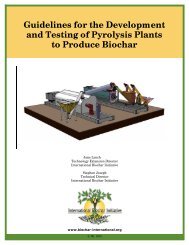Zambia in 2011 - International Biochar Initiative
Zambia in 2011 - International Biochar Initiative
Zambia in 2011 - International Biochar Initiative
Create successful ePaper yourself
Turn your PDF publications into a flip-book with our unique Google optimized e-Paper software.
P R OJ E C T R E P O R T<br />
BIOCHAR PRODUCTION<br />
USING<br />
THE PEKO PE STOVE<br />
IN<br />
ZAMBIA <strong>2011</strong>
PROJECT TITLE<br />
<strong>Biochar</strong> production us<strong>in</strong>g the Peko Pe stove <strong>in</strong> <strong>Zambia</strong><br />
CLIENT<br />
Miombo<br />
Postal address:<br />
7120 Leksvik, Norway<br />
Norwegian Geotechnical Institute (NGI)<br />
DISTRIBUTION<br />
NGI, Miombo<br />
Telephone: +47 47 75 17 40<br />
E-mail: miombo@miombo.no<br />
Org nr: 986 434 712 NO<br />
AUTHORS<br />
Terje Hoel<br />
Otto Formo<br />
DATE<br />
9 May 2012<br />
ABSTRACT<br />
This report details project work dur<strong>in</strong>g <strong>in</strong>troduction of 18 stoves to farmers <strong>in</strong> <strong>Zambia</strong>, October<br />
to November <strong>2011</strong>.<br />
The Peko Pe stove is characterized as a pyrolytic gasifier stove, produc<strong>in</strong>g a smokeless flame,<br />
provid<strong>in</strong>g heat for household cook<strong>in</strong>g. In addition the stove produces biochar for use <strong>in</strong><br />
agriculture.<br />
The project transferred knowledge on stove use and production of biochar through arranged<br />
stove sessions with farmers <strong>in</strong> Kaoma, Mongu and Mkushi. The stove <strong>in</strong>troduction was followed<br />
up with a later visit to the same farmers, verify<strong>in</strong>g use and proper biochar production.<br />
The adoption of the Peko Pe stove is believed to benefit from the stove's biochar production<br />
capability. Indirectly this capability responds to farmers' need for a change mechanism that leads<br />
to reduced demand for fertilizer and reduced biomass consumption <strong>in</strong> household cook<strong>in</strong>g.<br />
Corncobs are a widely available waste product <strong>in</strong> rural <strong>Zambia</strong> and tests proved that the Peko Pe<br />
stove worked well with this type of fuel.<br />
The high stove adoption rate with corn cobs as fuel, experienced dur<strong>in</strong>g the pilot-project are<br />
encourag<strong>in</strong>g and positions the Peko Pe stove for large scale implementation with farmers and for<br />
production of biochar.
Preface<br />
Miombo is grateful to the Norwegian Geotechnical Institute for the opportunity to present<br />
the Green Solution Concept to farmers <strong>in</strong> <strong>Zambia</strong> and for hav<strong>in</strong>g worked on the biochar<br />
project <strong>in</strong> <strong>Zambia</strong>.<br />
An equal acknowledgment is extended to the organization Conservation Farm<strong>in</strong>g Unit for<br />
assistance dur<strong>in</strong>g our work <strong>in</strong> <strong>Zambia</strong>. Special thanks go to the regional office of CFU <strong>in</strong><br />
Mkushi for valuable <strong>in</strong>put to the report.<br />
i
Table of contents<br />
1.0 INTRODUCTION ........................................................................................................ 1<br />
2.0 MOTIVATION ............................................................................................................ 1<br />
3.0 PROJECT OBJECTIVES, ORGANIZATION ................................................................ 2<br />
3.1 Objectives ......................................................................................................................... 2<br />
3.2 Project Organization ......................................................................................................... 3<br />
3.3 Work packages ................................................................................................................. 4<br />
3.4 The household energy sector <strong>in</strong> <strong>Zambia</strong> ........................................................................... 4<br />
3.5 The Green Solution Concept ............................................................................................. 5<br />
3.6 The Peko Pe stove............................................................................................................. 6<br />
3.7 Fuel for the Peko Pe.......................................................................................................... 8<br />
3.8 Production of the Peko Pe stove .................................................................................... 10<br />
3.9 Distribution of stoves and biomass fuel ......................................................................... 11<br />
3.10 Distribution and carbon offset programs ..................................................................... 12<br />
3.11 The Mbawula and the Peko Pe ..................................................................................... 13<br />
3.12 Use of biochar <strong>in</strong> conservation farm<strong>in</strong>g ........................................................................ 13<br />
4.0 PROJECT METHODOLOGY..................................................................................... 14<br />
4.1 Project plann<strong>in</strong>g.............................................................................................................. 14<br />
4.2 Stove production ............................................................................................................ 15<br />
4.3 Stove <strong>in</strong>troduction .......................................................................................................... 16<br />
4.4 Verification visit.............................................................................................................. 18<br />
4.5 Phase 2 review................................................................................................................ 19<br />
5.0 RESULTS AND DISCUSSION ................................................................................... 19<br />
5.1 Project work ................................................................................................................... 19<br />
5.2 Interviews from stove <strong>in</strong>troduction ................................................................................ 19<br />
5.3 Verification visit.............................................................................................................. 23<br />
6.0 CONCLUSIONS ........................................................................................................ 25<br />
7.0 LIST OF ANNEXES ................................................................................................... 25<br />
ii
Executive summary<br />
Household energy use and biochar <strong>in</strong> develop<strong>in</strong>g countries have ga<strong>in</strong>ed a tremendous <strong>in</strong>terest <strong>in</strong><br />
the past decade. Gender issues <strong>in</strong> particular, have put stoves on the agenda to policy decision<br />
makers and opened up for large scale implementation of new energy efficient stoves.<br />
Stoves based on pyrolytic gasification technology may hold the key to alleviate several thirdworld<br />
def<strong>in</strong>ed challenges. One of them be<strong>in</strong>g deforestation, another is susta<strong>in</strong>able and efficient<br />
agricultural practice, a third is health related diseases occurr<strong>in</strong>g as a result of toxic fumes<br />
spread<strong>in</strong>g <strong>in</strong> enclosed kitchen environments.<br />
Pyrolytic gasification stoves are energy efficient units with low levels of emissions. In some<br />
cases, less than 50% fuel consumption and 90% emissions reductions have been reached,<br />
compared to exist<strong>in</strong>g practice. These stoves possess a great flexibility with regard to choice of<br />
biomass. Residual waste products with<strong>in</strong> forestry and agriculture are often used as feedstock for<br />
these units. In addition to heat, pyrolytic gasification units turn the biomass <strong>in</strong>to biochar; a<br />
product expected to be <strong>in</strong> high demand <strong>in</strong> future agricultural practice.<br />
Norwegian Geotechnical Institute (NGI) contracted Miombo <strong>in</strong> September <strong>2011</strong> to execute a<br />
pilot stove project <strong>in</strong> <strong>Zambia</strong>. The pilot called for Miombo to supply and <strong>in</strong>troduce 18 units of<br />
the pyrolytic gasification stove Peko Pe to farmers <strong>in</strong> <strong>Zambia</strong> dur<strong>in</strong>g October and November<br />
2012.<br />
The project had two ma<strong>in</strong> objectives. One was to <strong>in</strong>troduce farmers to the Peko Pe stove for use<br />
<strong>in</strong> household cook<strong>in</strong>g. The other was to facilitate stove <strong>in</strong>troduction as a biochar production<br />
unit. NGI operates a NORAD funded biochar project <strong>in</strong> <strong>Zambia</strong>, seek<strong>in</strong>g a wider use of biochar <strong>in</strong><br />
agriculture, us<strong>in</strong>g conservation farm<strong>in</strong>g techniques.<br />
The farmers were located <strong>in</strong> two different regions of <strong>Zambia</strong>: Kaoma and Mongu <strong>in</strong> Western<br />
Prov<strong>in</strong>ce and Mkushi <strong>in</strong> Central Prov<strong>in</strong>ce of <strong>Zambia</strong>. At each location, selected farmers were<br />
<strong>in</strong>dividually <strong>in</strong>troduced to the Green Solution Concept and stove functionality. The Green<br />
Solution Concept focuses on us<strong>in</strong>g biomass waste resources. As such, corn cobs were selected as<br />
fuel for cook<strong>in</strong>g and biochar production.<br />
The Green Solution Concept permits low <strong>in</strong>come households, farmers and communities:<br />
To use solid waste biomass as fuel for cook<strong>in</strong>g<br />
To live <strong>in</strong> a less polluted and healthier kitchen environment<br />
To produce biochar for use on land used by the farmer or community<br />
To create more jobs with<strong>in</strong> the exist<strong>in</strong>g value cha<strong>in</strong> for charcoal<br />
To enable reduced costs on biomass<br />
The 18 units were transported from Norway to <strong>Zambia</strong> as carry-on air luggage. Out of these 18<br />
stoves, 6 units were complete units, while 12 units were produced as flat-packs. An aspect of the<br />
Green Solution Concept is to <strong>in</strong>volve local artisans and t<strong>in</strong>smiths for the production of the stoves<br />
and a mechanical workshop <strong>in</strong> Lusaka and t<strong>in</strong>smiths <strong>in</strong> Mongu were assigned stove assembly.<br />
The t<strong>in</strong>smiths immediately accepted the stove and responded with comments on the<br />
uncomplicated assembly procedure.<br />
The ma<strong>in</strong> conclusion from the field work <strong>in</strong> <strong>Zambia</strong> is that the micro-gasification Peko Pe stove<br />
was adopted and embraced by farmers and households. The different types of fuels that can be<br />
used <strong>in</strong> the stove and the fact that the stove produces biochar are value added characteristics.<br />
The positive response from farmers and others are encourag<strong>in</strong>g and motivates to a future large<br />
scale-up <strong>in</strong> <strong>Zambia</strong>.<br />
iii
1.0 Introduction<br />
Norwegian Geotechnical Institute (NGI) stated an <strong>in</strong>terest <strong>in</strong> July <strong>2011</strong> to reta<strong>in</strong> the pyrolytic<br />
gasification stove Peko Pe for its current NORAD funded agricultural project <strong>in</strong> <strong>Zambia</strong>:<br />
"<strong>Biochar</strong> <strong>in</strong> conservation farm<strong>in</strong>g <strong>in</strong> <strong>Zambia</strong>", hereafter referred to as “NGI <strong>Biochar</strong> Project”.<br />
The purpose of the NGI <strong>Biochar</strong> Project is to "… <strong>in</strong>vestigate the potential of organic waste<br />
biochar to sequester carbon and improve the quality of weathered and/or acidic <strong>Zambia</strong>n<br />
soils" 1 . Early results have been very promis<strong>in</strong>g with reported yields on corn up to four times<br />
versus control 2 . The project is organized as a collaborative project between NGI and the<br />
<strong>Zambia</strong>n farm<strong>in</strong>g organization Conservation Farm<strong>in</strong>g Unit (CFU).<br />
NGI contracted Miombo <strong>in</strong> October <strong>2011</strong> to execute the pilot project <strong>in</strong> <strong>Zambia</strong>. A total of 18<br />
Peko Pe stoves were ordered by NGI under a contract, call<strong>in</strong>g for stoves to be placed with a<br />
similar number of farmers participat<strong>in</strong>g <strong>in</strong> the NGI biochar project. The farmers were located<br />
at Kaoma, Mongu and Mkushi <strong>in</strong> <strong>Zambia</strong>. In addition to stoves, the contract <strong>in</strong>cluded services<br />
related to tra<strong>in</strong><strong>in</strong>g, guidance and verification of stove usage – both <strong>in</strong> household cook<strong>in</strong>g and<br />
production of biochar.<br />
2.0 Motivation<br />
There are four ma<strong>in</strong> motivators for use of pyrolytic gasification stoves <strong>in</strong> develop<strong>in</strong>g<br />
countries.<br />
<br />
<br />
<br />
<br />
Health issues related to reduced emissions<br />
Reduced deforestation and reduced biomass consumption<br />
Climate change mitigation and adaption<br />
<strong>Biochar</strong> production<br />
On top of the list is the immediate effect of improved health. WHO has issued several<br />
publications 3 document<strong>in</strong>g the high third world death rates caused by pollutants from open<br />
fire and air pollut<strong>in</strong>g stoves. The current cook<strong>in</strong>g practice is dubbed "killer <strong>in</strong> the kitchen" 4 as<br />
women and children are directly exposed to pollutants dur<strong>in</strong>g cook<strong>in</strong>g. The high death rates<br />
and disease <strong>in</strong>cidents have caused much <strong>in</strong>dignation and rage as <strong>in</strong>dustrialized countries<br />
have paid little attention to this basic third world problem. The heightened <strong>in</strong>terest to<br />
reduce these problems has made possible the formation of The Global Alliance for Clean<br />
Cookstoves (GAAC) 5 and unprecedented fund<strong>in</strong>g levels from several countries have helped<br />
the organization move rapidly and with strength. The organization aims high and seeks<br />
<strong>in</strong>troduction of new stoves with 90% reduction <strong>in</strong> air pollutants and 50% reduced biomass<br />
consumption, all compared to exist<strong>in</strong>g practice. Norway is a found<strong>in</strong>g partner for this<br />
organization. Miombo is acknowledged as an implement<strong>in</strong>g partner and is actively work<strong>in</strong>g<br />
with<strong>in</strong> this organization as a member of the work<strong>in</strong>g group: "Technology and Fuel".<br />
1 G. Cornelissen, "Improved crop yield and stor<strong>in</strong>g carbon, Progress report March <strong>2011</strong>", NGI, <strong>2011</strong><br />
2 G. Cornelissen, personal communication<br />
3 See e.g. "Fuel for life : household energy and health", WHO, 2006, and the UNDP-WHO jo<strong>in</strong>t report<br />
“The energy access situation <strong>in</strong> develop<strong>in</strong>g countries”, 2009.<br />
4 "Fuel for life : household energy and health", WHO, 2006.<br />
5 See cleancookstoves.org/<br />
1
Climate change issues have put focus on efficient use of biomass. With little economic access<br />
to fossil fuels such LPG and kerosene, third world populations are relented to use biomass<br />
for cook<strong>in</strong>g and other household energy. This practice<br />
is most often l<strong>in</strong>ked to deforestation and other<br />
climate change effects. New stoves have higher<br />
thermal efficiencies caus<strong>in</strong>g less biomass to be used<br />
for cook<strong>in</strong>g.<br />
The gender effect from less biomass consumption is<br />
seen as reduced time for women spent on biomass<br />
collection. New efficient stoves will <strong>in</strong>directly effect<br />
changes <strong>in</strong> social structures and exemplifies why<br />
stove <strong>in</strong>troduction need to be viewed <strong>in</strong> a value cha<strong>in</strong><br />
perspective.<br />
Lastly the motivation for <strong>in</strong>troduction of stoves with<br />
pyrolytic gasification technology is founded <strong>in</strong> the<br />
Figure 1: Peko Pe stove user <strong>in</strong> <strong>Zambia</strong><br />
Photo: Miombo<br />
possibility to produce biochar. The Peko Pe stove is a solution provider for small scale<br />
farmers, seek<strong>in</strong>g a biochar production unit for agricultural use of biochar on their own farm.<br />
The qualities of biochar are reduced fertilizer use and <strong>in</strong>creased crop-yields. Both of these<br />
factors are <strong>in</strong>come generators for local farmers. The society on a whole benefits from more<br />
susta<strong>in</strong>able farm<strong>in</strong>g practices.<br />
3.0 Project objectives, organization<br />
3.1 Objectives<br />
The objectives of the pilot-project were:<br />
1. Introduction of stoves<br />
The primary objective was to secure placement of stoves with a preselected number of<br />
farmers.<br />
To <strong>in</strong>troduce the Peko Pe stove to 18 rural households<br />
To facilitate the <strong>in</strong>troduction of the Peko Pe stove as a biochar produc<strong>in</strong>g unit<br />
and to produce biochar <strong>in</strong> small quantities us<strong>in</strong>g corn cobs as feedstock.<br />
2. Verification visit<br />
Production of biochar was NGI’s primary motive for <strong>in</strong>tegrat<strong>in</strong>g the Peko Pe unit <strong>in</strong>to<br />
the exist<strong>in</strong>g project. The pilot project therefore aimed at:<br />
Transfer of knowledge and verify proper use of stove and biochar production by<br />
end-users<br />
3. Preparatory work for a phase 2<br />
Plann<strong>in</strong>g activities were considered for a phase 2 project with large scale stove<br />
implementation. An aim of the pilot-project was therefore:<br />
To review and plan for a phase 2, where the Green Solution Concept could be<br />
fully implemented on a larger scale<br />
2
3.2 Project Organization<br />
Otto Formo from Miombo was assigned the task to organize the pilot-project and set-up a<br />
team to execute tasks <strong>in</strong> Norway and <strong>Zambia</strong>.<br />
The diagram <strong>in</strong> figure 2 shows project organization. The work tasks reported on <strong>in</strong> this report<br />
relates to work tasks with Terje Hoel and Otto Formo as assigned personnel.<br />
NGI<br />
Gerard Cornelissen<br />
Miombo<br />
Otto Formo<br />
Project leader<br />
Terje Hoel<br />
Task leader<br />
Jan Sørensen<br />
New Energy Systems<br />
Project assistance<br />
Paal Wendelbo<br />
Stove quality<br />
assurance<br />
Vetle Wendelbo Cappelen<br />
Task leader<br />
Team <strong>in</strong> <strong>Zambia</strong><br />
Figure 2: Project organization<br />
3
3.3 Work packages<br />
Miombo’s work was separated <strong>in</strong>to preparatory work <strong>in</strong> Norway and stove <strong>in</strong>troduction<br />
related tasks <strong>in</strong> <strong>Zambia</strong>.<br />
The table below shows <strong>in</strong>dividual work packages (WP) and assigned personnel as the work<br />
proceeded dur<strong>in</strong>g the project. The table as such differs from the orig<strong>in</strong>al project plann<strong>in</strong>g<br />
document.<br />
WP<br />
No WP description Location Result Responsible Personnel<br />
1.0 Introduction of the Peko Pe stove<br />
1.1 Production of stoves Norway 18 Peko Pe<br />
stoves<br />
1.2 Introduction <strong>in</strong> stove<br />
use and production of<br />
biochar<br />
<strong>Zambia</strong><br />
Transfer of<br />
knowledge on<br />
stove use, and<br />
a limited<br />
production of<br />
biochar<br />
1.3 Verification visit <strong>Zambia</strong> Transfer of<br />
knowledge,<br />
verification of<br />
stove use and<br />
production of<br />
biochar<br />
2.0 Preparatory work for a phase 2 project<br />
Vetle Wendelbo<br />
Cappelen<br />
Otto Formo<br />
Otto Formo<br />
Otto Formo<br />
Terje Hoel<br />
Paal Wendelbo<br />
Vetle Cappelen<br />
Otto Formo<br />
Terje Hoel<br />
Otto Formo<br />
Terje Hoel<br />
2.1 Preparatory work for a<br />
phase 2<br />
<strong>Zambia</strong> Data collection Terje Hoel<br />
Vetle W. Cappelen<br />
Otto Formo<br />
Terje Hoel<br />
Vetle Cappelen<br />
3.0 Project adm<strong>in</strong>istration<br />
Table 1: Project work packagesHousehold energy and biochar<br />
3.4 The household energy sector <strong>in</strong> <strong>Zambia</strong><br />
In <strong>Zambia</strong>, like <strong>in</strong> many other develop<strong>in</strong>g<br />
countries, more than 80% of the energy<br />
demand is covered by biomass, ma<strong>in</strong>ly as<br />
firewood or charcoal for household cook<strong>in</strong>g.<br />
Charcoal is the most common commodity,<br />
produced <strong>in</strong> rural areas and used <strong>in</strong> urban<br />
sett<strong>in</strong>gs. It is an important bus<strong>in</strong>ess sector of<br />
the nation, estimated to <strong>in</strong>volve 500 000 6<br />
persons or roughly 3 % of the <strong>Zambia</strong>n<br />
population.<br />
Figure 3: Traditional charcoal mak<strong>in</strong>g<br />
Photo: Miombo<br />
6 Gumbo, Presentation <strong>2011</strong><br />
www.ciga.unam.mx/redd/images/charcoal/presentations/8_Gumbo_Mwaanga_<strong>Zambia</strong>_Kapiri_poverty_LUC.pdf<br />
4
The use of charcoal and open three stone fires is an <strong>in</strong>efficient use of energy. Produc<strong>in</strong>g<br />
charcoal <strong>in</strong> a traditional kiln typically causes an energy loss of more than 60% 7 . At the same<br />
time emissions from open fires contribute to climate change (methane, CO 2 ) and causes<br />
substantial release of toxic emissions (CO, PM).<br />
<strong>Zambia</strong> has abundant amounts of waste<br />
biomass, both as forestry- and agricultural<br />
waste. Most of this waste does not f<strong>in</strong>d a use.<br />
These resources may well replace wood and<br />
charcoal as fuel. For low <strong>in</strong>come households <strong>in</strong><br />
rural areas, unprocessed fuel e.g. corn cobs, can<br />
be collected for storage, and be an <strong>in</strong>expensive<br />
year round household fuel. An often found<br />
biomass residual product is sawdust. Sawdust<br />
f<strong>in</strong>ds no use and piles up at company sites. With<br />
low tech pellets mach<strong>in</strong>ery, adapted for<br />
develop<strong>in</strong>g countries, this waste product may be<br />
processed to pellets and sold <strong>in</strong> urban areas for<br />
use <strong>in</strong> the Peko Pe stove.<br />
Figure 4: Charcoal bags ready for<br />
transportation to urban areas<br />
Photo: Miombo<br />
3.5 The Green Solution Concept<br />
Miombo has for several years targeted the household energy sector <strong>in</strong> develop<strong>in</strong>g countries<br />
through its Green Solution Concept. The concept provides a framework for other processes<br />
us<strong>in</strong>g pyrolytic gasifiers such as a change<br />
mechanism.<br />
Figure 5 shows the circular value cha<strong>in</strong> of the<br />
Green Solution Concept. The Peko Pe stove is<br />
one part <strong>in</strong> a set of l<strong>in</strong>ked elements. Of utmost<br />
concern is the selection of suitable waste<br />
biomass, sourced <strong>in</strong> a susta<strong>in</strong>able life cycle<br />
perspective. The concept <strong>in</strong>cludes biochar and<br />
the possibility for <strong>in</strong>creased agricultural yields<br />
and related <strong>in</strong>come through carbon offsets.<br />
Agriculture and Susta<strong>in</strong>able Forest Management<br />
is a natural part of the concept. The concept<br />
addresses a cluster of other development<br />
priorities <strong>in</strong>clud<strong>in</strong>g health, gender issues and<br />
natural resources management and climate<br />
change.<br />
Figure 5. Schematics of the Green Solution<br />
Concept<br />
Source: Miombo<br />
An important prerequisite of the concept is the availability of local biomass resources<br />
suitable for use <strong>in</strong> pyrolytic gasifiers. The concept is relevant for other energy sources such<br />
as biogas, ethanol, w<strong>in</strong>d and solar, either as a comb<strong>in</strong>ation of energy units or as a modified<br />
concept to suit particular areas or needs.<br />
7 SINTEF, personal communication <strong>2011</strong><br />
5
The concept is based on <strong>in</strong>troduction at the community level to benefit low <strong>in</strong>come<br />
households and small scale bus<strong>in</strong>ess development and job creation. This can either be l<strong>in</strong>ked<br />
to collection or production of fuel, or the skills of t<strong>in</strong>smiths to produce the stove. For further<br />
references on the Green Solution Concept, see poster (Annex 3).<br />
Def<strong>in</strong>ition:<br />
The Green Solution Concept is based on the use of pyrolytic gasifiers, comb<strong>in</strong>ed with suitable<br />
processed or unprocessed waste biomass, search<strong>in</strong>g susta<strong>in</strong>able life-cycle processes. The<br />
pyrolytic gasifiers are clean burn<strong>in</strong>g, energy efficient, and adaptable for low <strong>in</strong>come<br />
households and easy to produce or replicate locally by t<strong>in</strong>smiths. The stoves produce biochar<br />
for use by local farmers as a soil improver and carbon s<strong>in</strong>k.<br />
3.6 The Peko Pe stove<br />
The Peko Pe stove converts biomass to a smokeless flame for use <strong>in</strong> cook<strong>in</strong>g, heat<strong>in</strong>g. It is a<br />
micro charcoal kiln designed for use <strong>in</strong> low <strong>in</strong>come households <strong>in</strong> develop<strong>in</strong>g countries. Its<br />
pr<strong>in</strong>cipal feature is a smokeless flame. The stove's products are heat and biochar.<br />
The Peko Pe is a pyrolytic gasification unit, which accepts a wide range of different types of<br />
biomass, such as corn cobs, chopped wood, a variety of nut shells, straw, etc. The stove<br />
belongs to the stove category of TLUD-ND (Top Lit Up Draft – Natural Draft).<br />
The stove’s flexibility with regard to biomass allows<br />
end-users to choose between different sources of<br />
biomass, many of these categorized as waste<br />
products.<br />
The simple design and construction, based on<br />
natural draft combustion pr<strong>in</strong>ciples and assembled<br />
<strong>in</strong> an uncomplicated manufactur<strong>in</strong>g process, makes<br />
the stove easily accepted by local t<strong>in</strong>smiths.<br />
The Peko Pe comb<strong>in</strong>es the processes of gasification<br />
and pyrolysis. The heat used for cook<strong>in</strong>g orig<strong>in</strong>ates<br />
from the combustion of gases provided by the<br />
biomass gasification process. Before gasification,<br />
the biomass is reduced to combustible vapours <strong>in</strong><br />
an oxygen starved atmosphere.<br />
Figure 6: Peko Pe stove<br />
Photo: Cacious Mubita, CFU<br />
Dur<strong>in</strong>g gasification, the flames burn with a temperature between 550 to 750°C dependent<br />
on the conditions for combustion. In the fuel chamber, the pyrolysis process operates at a<br />
temperature of 400 to 500°C. At the end of the burn, the flame will run out and the charcoal<br />
temperature drops down to approximately 300°C. The temperature is reduced with the<br />
reduction of heat <strong>in</strong> the simmer<strong>in</strong>g of solid carbon. The Peko Pe stove is at the end of the<br />
burn useful for low temperature cook<strong>in</strong>g such as water simmer<strong>in</strong>g and to keep food warm.<br />
The limited air <strong>in</strong> the fuel chamber makes the simmer<strong>in</strong>g of carbon long last<strong>in</strong>g.<br />
The characteristics of pyrolytic gasifiers are that the outputs of charcoal and combustible<br />
gases are separated <strong>in</strong> time and place. This leaves an opportunity to collect the charcoal for<br />
other purposes after cook<strong>in</strong>g on the combustible gases.<br />
6
An alternative use of charcoal is to comb<strong>in</strong>e the use of the Peko Pe with a charcoal stove<br />
such as the Mbawula. Charcoal from the Peko Pe may be used for further cook<strong>in</strong>g <strong>in</strong> the<br />
Mbawula with temperatures of 700-900°C.<br />
To use the charcoal as biochar is another option. <strong>Biochar</strong> is crushed charcoal used as a soil<br />
improver. Due to pyrolysis temperatures between 400 and 500 °C, it is expected that the<br />
Peko Pe produces biochar of high quality 8 .<br />
The charcoal is emptied from the fuel<br />
chamber and spr<strong>in</strong>kled with water or sand<br />
to stop the combustion process. It is stored<br />
for later spread<strong>in</strong>g on land and mixed <strong>in</strong>to<br />
soil with available tools.<br />
The biochar yield <strong>in</strong> the Peko Pe is typically<br />
25%. The carbon content <strong>in</strong> the biochar is<br />
roughly 90%.<br />
A limited number of improved cook stoves<br />
have the capability to reduce consumption<br />
of wood by 50% and reduce emissions of<br />
toxic gasses by 90% 9 . The Peko Pe stove has<br />
not been tested with the specific <strong>in</strong>tention<br />
Figure 7: <strong>Biochar</strong> <strong>in</strong> plant<strong>in</strong>g bas<strong>in</strong>s, conservation<br />
farm<strong>in</strong>g<br />
Photo: Miombo<br />
to compare aga<strong>in</strong>st these rigorous standards, but it is Miombo's view that the Peko will pass<br />
these standards. This is based on experience from field work and Miombo held verification<br />
tests. The stove is currently (March 2012) undergo<strong>in</strong>g test<strong>in</strong>g at U.S. Environmental<br />
Protection Agency (EPA) and Miombo awaits the results from these tests.<br />
Based on prior stove test<strong>in</strong>g at EPA, TLUD stoves seems to have the best potential to comply<br />
with stove air quality requirements and stove efficiency requirements. They are flexible <strong>in</strong><br />
choice of fuel, but need dry biomass for stove process<strong>in</strong>g. Some waste biomass categories<br />
need no pretreatment and can be used <strong>in</strong> the stove as-is e.g. corn cobs, forestry debris and<br />
shells from a variety of nuts.<br />
The Peko Pe was developed over an extended period of time by the architect Paal<br />
Wendelbo. The stove was at first <strong>in</strong>troduced <strong>in</strong> the East Moyo refugee camp of Ajumani <strong>in</strong><br />
Uganda <strong>in</strong> 1995. In this camp the stove was adopted and <strong>in</strong> use by a cook for up to three<br />
times a day for one year, us<strong>in</strong>g Hyperhenia Rufa grass as feedstock. The women named it<br />
Peko Pe, which <strong>in</strong> the local language means “It will solve our problems”. The stove was<br />
tested at the Technical University of Copenhagen <strong>in</strong> 1996.<br />
8 T.J. K<strong>in</strong>ney, C.A. Masiello, B. Dugan, W.C. Hockaday, M.R. Dean, K. Zygourakis, R.T. Barnes. Hydrologic properties<br />
of biochars produced at different temperatures. Biomass and Bioenergy, 2012.<br />
9 "Biomass Cookstoves Technical Meet<strong>in</strong>g: Summary Report", U.S. Department of Energy, <strong>2011</strong>, page VII.<br />
7
3.7 Fuel for the Peko Pe<br />
Use of solid biomass as a fuel <strong>in</strong> the Peko Pe should adhere to the follow<strong>in</strong>g characteristics:<br />
<br />
<br />
Biomass should be “dry”, which means a moisture content of preferably below<br />
10%. Any water <strong>in</strong> the fuel will have to be evaporated at the expense of heat<br />
availability for the actual cook<strong>in</strong>g. High moisture content also <strong>in</strong>fluences stove<br />
operation as well.<br />
The biomass should be “energy-dense”. If the fuel has low energy density, the<br />
same cook<strong>in</strong>g tasks requires the burn<strong>in</strong>g of much higher volumes. This may<br />
result <strong>in</strong> <strong>in</strong>conveniences for the user. The user either has to accept a much larger<br />
stove (batch feed) or a very cumbersome cook<strong>in</strong>g process (frequent refuell<strong>in</strong>g<br />
cont<strong>in</strong>uous feed stove).<br />
The mentioned Green Solution Concept emphasizes that biomass should not compete with<br />
resources allocated for food production. Examples are land, water, labour, fertiliser etc., or<br />
any higher value use, such as a build<strong>in</strong>g material.<br />
Other qualify<strong>in</strong>g factors are that biomass should not negatively impact biodiversity of the<br />
locality; must generate profits at relevant sublevels of the value cha<strong>in</strong>; must be susta<strong>in</strong>ably<br />
managed so that it truly may be identified as a renewable energy source.<br />
Figure 8: Various sources of biomass for the Peko Pe<br />
Photo: Miombo<br />
The Peko Pe stove allows different types of fuel such as: corn cobs, chopped/chipped wood,<br />
branches, grass, groundnut shells, briquettes and pellets.<br />
Table 2 is reproduced from FAO 10 and lists various wood and crop fuels. Excluded from a list<br />
of possible feedstocks are municipal refuse products. These potential feedstocks are<br />
characterized by a high variability and do most often conta<strong>in</strong> toxic elements.<br />
10<br />
FAO, Forestry Department, “Unified Bioenergy Term<strong>in</strong>ology “, 2004<br />
ftp://ftp.fao.org/docrep/fao/007/j4504e/j4504e00.pdf, page 9<br />
8
Table 2: Classification of biofuels<br />
Source: FAO, 2004<br />
Crop residues from agriculture are the largest source of non-timber biomass fuel. Common<br />
types are:<br />
straw, stem, stalks, leaves, husk, shells, peels, l<strong>in</strong>t, stones, pulp, stubble, etc. which come from<br />
cereals (rice, wheat, maize or corn, sorghum, barley, millet), cotton, groundnut, jute, legumes,<br />
coffee, cacao, olive, tea, fruits (banana, mango, coco, cashew) and palm oil.<br />
Figure 9: An example of crop residuals; corn cobs used <strong>in</strong><br />
the Peko Pe dur<strong>in</strong>g the pilot-project<br />
Photo: Miombo<br />
Agricultural residues are generated <strong>in</strong> large volumes, season by season, and are often<br />
discarded as waste and not put to use. A summary of advantages and disadvantages of<br />
waste products for use <strong>in</strong> the Peko Pe is listed <strong>in</strong> table 3.<br />
9
Advantages<br />
Disadvantages<br />
<br />
<br />
<br />
<br />
<br />
Agricultural residues are available<br />
for free or at low cost<br />
Application of waste products <strong>in</strong><br />
energy devices is first-rate waste<br />
management. Huge rott<strong>in</strong>g piles<br />
exhausts productive land when<br />
stored or destroy soil organisms <strong>in</strong><br />
the fields while be<strong>in</strong>g burnt<br />
Residues are often available close<br />
to the household; reduc<strong>in</strong>g<br />
women’s time for harvest<strong>in</strong>g and<br />
transport<br />
Agricultural residues are often<br />
easier to lit than wood and<br />
charcoal<br />
Agricultural residues substitute or<br />
complement firewood and puts<br />
less stress on timber-resources<br />
<br />
<br />
<br />
<br />
<br />
Agricultural residues often require<br />
appropriate stoves to burn well, e.g.<br />
gasifier stoves.<br />
Agricultural residues are bulky and<br />
storage requires more space<br />
Agricultural residues are often limited<br />
to seasonal availability of crops<br />
Agricultural residues may have a shorter<br />
burn time per volume/weight of fuel.<br />
For the same cook<strong>in</strong>g task, more fuel is<br />
required as compared to wood.<br />
If agricultural residues conta<strong>in</strong> large<br />
proportions of oils or prote<strong>in</strong>s, the<br />
burn<strong>in</strong>g properties change (e.g. smoke)<br />
and need to be addressed with an<br />
appropriate stove technology<br />
Table 3. Summary of waste product characteristics, Source: Miombo<br />
3.8 Production of the Peko Pe stove<br />
The stove consists of an <strong>in</strong>ner combustion chamber with a bottom plate, four legs, outer<br />
cyl<strong>in</strong>der, two handles, top lid and a three pot stand.<br />
Primary air <strong>in</strong>take limits the volume of air <strong>in</strong>to lower part of the stove, but sufficient to keep<br />
air flow and ma<strong>in</strong>ta<strong>in</strong> the biomass gasification process to run cont<strong>in</strong>uously. A gap between<br />
the combustion chamber and the top lid secures secondary air for mix<strong>in</strong>g of gases and<br />
complete combustion.<br />
It is recommended to manufacture the Peko Pe <strong>in</strong> acid proof sta<strong>in</strong>less steel to assure long<br />
life span. Other materials such as mild steel will corrode more easily. In addition, mild steel<br />
transfer heat more easily to the outer cyl<strong>in</strong>der, caus<strong>in</strong>g mild sk<strong>in</strong> irritation when touched.<br />
The use of acid proof sta<strong>in</strong>less steel is up to five times more expensive than mild steel, and<br />
market preferences will determ<strong>in</strong>e the choice between the two materials. The expected life<br />
span with acid proof sta<strong>in</strong>less steel is expected to be 10 years mak<strong>in</strong>g this material a first<br />
choice.<br />
10
Early cost analysis shows that the stove will be<br />
manufactured at a cost of between ZKw 50.000 (US$ 10)<br />
to 300.000 (US$ 57). The material costs is expected to<br />
vary between ZKw 30.000 (US$ 6) to 200.000 (US$ 38)<br />
depend<strong>in</strong>g on material.<br />
Critical sections, such as primary and secondary air <strong>in</strong>let,<br />
must be precisely assembled and attached dur<strong>in</strong>g<br />
production. These <strong>in</strong>lets ensure optimal combustion.<br />
Quality assurance may be implemented us<strong>in</strong>g prefabricated<br />
flat-packs. Flat-packs may function as<br />
templates and will <strong>in</strong>fluence t<strong>in</strong>smiths to use<br />
standardized materials and sizes.<br />
It is anticipated that assembly l<strong>in</strong>es established <strong>in</strong> larger<br />
cities and towns will have production rates of ten to<br />
twelve Peko Pe stoves per person a day.<br />
Figure 10: T<strong>in</strong>smith produc<strong>in</strong>g the<br />
Peko Pe<br />
Photo: Miombo<br />
Us<strong>in</strong>g flat-packs have the added advantage of easy<br />
transport to rural areas. The Peko Pe is characterized by<br />
simple design and uncomplicated assembly, matched to the skills of tra<strong>in</strong>ed t<strong>in</strong>smiths, a<br />
common trade <strong>in</strong> e.g. Africa.<br />
An assembly l<strong>in</strong>e will have low tool requirements. Necessary tools are: simple hand tools,<br />
hammer, metal scissor, spikes, screw driver, truck spr<strong>in</strong>gs or parts of a railway l<strong>in</strong>e.<br />
3.9 Distribution of stoves and biomass fuel<br />
Several strategies for the distribution of the Peko Pe stove could be considered. Besides<br />
<strong>in</strong>troduc<strong>in</strong>g the stove to networks of end-users, a promotion campaign would be necessary<br />
to create a wider <strong>in</strong>terest <strong>in</strong> the market. Introduction of new stoves is with<strong>in</strong> the <strong>in</strong>timate<br />
sphere of family life, and attention from politicians and traditional leadership would have<br />
strong effects on legitimacy.<br />
Tra<strong>in</strong><strong>in</strong>g programs of local t<strong>in</strong>smiths to manually manufacture stoves could be one strategy.<br />
The t<strong>in</strong>smiths could use templates and local materials and assemblestoves <strong>in</strong>dividually.<br />
Pelletized sawdust and wood may be distributed with<strong>in</strong> the exist<strong>in</strong>g value cha<strong>in</strong>s for<br />
charcoal. The opportunity therefore exists to exploit present distribution structures and at<br />
the same time engage and support these structures through added commercial activity.<br />
Another strategy is to establish hubs to manufacture stoves <strong>in</strong> comb<strong>in</strong>ation with or l<strong>in</strong>ked to<br />
storehouses for fuel. It is believed that such a strategy would create l<strong>in</strong>kages between<br />
t<strong>in</strong>smiths, fuel producers and transporters through e.g. promotion and use of a common<br />
trademark foster<strong>in</strong>g job creation and local bus<strong>in</strong>ess development.<br />
11
3.10 Distribution and carbon offset programs<br />
Carbon offset programs are a promis<strong>in</strong>g way of f<strong>in</strong>anc<strong>in</strong>g projects aim<strong>in</strong>g at climate change<br />
mitigation. Carbon offsets represent emissions of carbon dioxide (CO 2 ) and may be traded as<br />
certified carbon credits on the <strong>in</strong>ternational carbon market. The Clean Development<br />
Mechanism (CDM) under the Kyoto Protocol<br />
and Voluntary Carbon Credits under the Gold<br />
Standard, are two well known systems where<br />
stove projects may f<strong>in</strong>d carbon credit<br />
purchasers.<br />
Through offer<strong>in</strong>g carbon credits, a stove<br />
project may obta<strong>in</strong> long term f<strong>in</strong>anc<strong>in</strong>g and<br />
operate profitable. Carbon offset programs<br />
for stoves are strongly related to the<br />
distribution of stoves and its fuel.<br />
Fuel efficient stoves are more expensive than Figure 11: Transport of charcoal<br />
exist<strong>in</strong>g charcoal stoves. The challenge is<br />
Photo: Miombo<br />
therefore to f<strong>in</strong>d new bus<strong>in</strong>ess models that<br />
permit large scale distribution of new efficient stoves.<br />
The performance characteristics of the Peko Pe stove makes it apt for <strong>in</strong>clusion <strong>in</strong> carbon<br />
offset programs. Many stoves, the Peko Pe <strong>in</strong>cluded, are fuel efficient and reducewood<br />
consumption.. Generated stove carbon offsets are based on thermal efficiency differences<br />
compared to exist<strong>in</strong>g practice. The amount of avoided CO2 <strong>in</strong> tons, related to the use of a<br />
Peko Pe stove, can be measured and will qualify for carbon credits.<br />
Recent carbon offset developments suggest to <strong>in</strong>corporate the mitigation effect of reduced<br />
emissions from CO2, particular matter (PM) and other green house gases. It is believed that<br />
the emissions of these pollutants, often described as black carbon, <strong>in</strong>creases global<br />
temperatures by absorb<strong>in</strong>g heat and forces ice melt<strong>in</strong>g. The Peko Pe stove's ability to avoid<br />
carbon emissions by 50% should be of <strong>in</strong>terest to carbon credit purchasers.<br />
The Peko Pe is furthermore produc<strong>in</strong>g biochar, which enables it to be used as a soil improver<br />
and to be used as a long-term storage medium for carbon. Several sources describe<br />
biochar’s capacity to permanently store carbon 11 . Scientists are assured that this occurs on<br />
scale of at least several hundred years 12 .<br />
To obta<strong>in</strong> carbon credits a project would need substantial fund<strong>in</strong>g to produce the required<br />
documentation, as well as cover the costs of tests and validation. A system for verified stove<br />
use has to be developed and may consist of a unique serial number stamped on each stove<br />
(or flat-pack) and a related database for storage of serial number, cell-phone number, as<br />
well as name and address of the user. This <strong>in</strong>formation may later be used for retrieval of<br />
warranty claims and claims for carbon offset credits.<br />
11 See e.g. "<strong>Biochar</strong> for environmental management: science and technology", Lehman & Joseph (eds), Earthscan,<br />
2009<br />
12 Ibid.<br />
12
3.11 The Mbawula and the Peko Pe<br />
There are many different types of stoves on the market <strong>in</strong> <strong>Zambia</strong>. Most often these stoves<br />
are associated with low thermal efficiencies.<br />
New stoves are therefore <strong>in</strong>troduced with the promotional pitch of hav<strong>in</strong>g high thermal<br />
efficiencies. Their lower biomass consumption makes them act as fuel sav<strong>in</strong>g devices. Social<br />
structures are difficult to modify. Even though new stoves are more efficient, low <strong>in</strong>come<br />
households <strong>in</strong> <strong>Zambia</strong> mostly use the traditional three stone fires or the charcoal stove,<br />
Mbawula.<br />
The ma<strong>in</strong> challenge <strong>in</strong> new stove <strong>in</strong>troduction is to divert focus away from stoves and on to<br />
the biomass available as fuel for the end-user. With different types of biomass as fuel, endusers<br />
can choose accord<strong>in</strong>g to season and area.<br />
The charcoal stove, Mbawula, is the most common<br />
stove <strong>in</strong> <strong>Zambia</strong>. It was <strong>in</strong>troduced <strong>in</strong> the 1970’s and<br />
an estimated 420 000 units 13 are <strong>in</strong> use <strong>in</strong> Lusaka,<br />
<strong>Zambia</strong>. Cecil Cook estimates that life span is at 15<br />
months with costs rang<strong>in</strong>g between K6 000 to<br />
K50 000 (USD 1 – USD 12.50) depend<strong>in</strong>g on size and<br />
material used. An average retail cost is put at K7500<br />
(USD 1.75)<br />
Miombo estimates that the Mbawula consumes 1.7<br />
kg of charcoal per day at a common household.<br />
Figure 12: Mbawula stove with<br />
simmer<strong>in</strong>g char from corn cobs.<br />
Photo: Miombo<br />
3.12 Use of biochar <strong>in</strong> conservation farm<strong>in</strong>g<br />
The most suitable areas <strong>in</strong> <strong>Zambia</strong> for biochar use seem to be on sandy soils with low<br />
moisture content and typically acidic soils with low capacity for farm<strong>in</strong>g purposes. 14<br />
Farmers <strong>in</strong> <strong>Zambia</strong> use <strong>in</strong>dustrialized fertilizer. Deliveries are sporadic and often too late for<br />
the plant<strong>in</strong>g season. An option to the farmer is to buy fertilizer from the private sector, but<br />
most farmers do not have the economic foundation for this choice as the fertilizer is too<br />
expensive.<br />
Early test results show that conservation farm<strong>in</strong>g techniques <strong>in</strong> comb<strong>in</strong>ation with biochar is a<br />
favourable arrangement 15 . Corn gives residual products as stalks and corn cobs. These<br />
resources are excellent fuel for the Peko Pe.<br />
13 Personal communication, Cecil Cook, Lusaka <strong>2011</strong><br />
14 G. Cornelissen, "<strong>Biochar</strong> <strong>in</strong> conservation farm<strong>in</strong>g <strong>in</strong> <strong>Zambia</strong>", NGI, <strong>2011</strong><br />
15 G. Cornelissen, "<strong>Biochar</strong> <strong>in</strong> conservation farm<strong>in</strong>g <strong>in</strong> <strong>Zambia</strong>", NGI, <strong>2011</strong><br />
13
A crude calculation gives an average biomass consumption of 2.5 kg per day for household<br />
cook<strong>in</strong>g. A farmer would be able to produce 230 kg of biochar annually. It is estimated that<br />
four tons of biochar is needed to give some notable <strong>in</strong>fluence on crop yields on 1 hectare of<br />
land. The amount of biochar needed for an average small scale farmers unit of 1 lima (0,25<br />
hectare) will take 4 to 5 years. This is considered a long term <strong>in</strong>vestment, and must be<br />
dist<strong>in</strong>guished from fertilizers which need to be added every year.<br />
Figure 13: Corn cobs as biochar left and placed <strong>in</strong> the soil, us<strong>in</strong>g conservation farm<strong>in</strong>g<br />
techniques. Photo: Miombo<br />
4.0 Project methodology<br />
4.1 Project plann<strong>in</strong>g<br />
Miombo’s assignment <strong>in</strong> <strong>Zambia</strong> spanned a three week period, start<strong>in</strong>g end of October <strong>2011</strong>.<br />
Preparations <strong>in</strong> Norway <strong>in</strong>cluded plann<strong>in</strong>g and stove production.<br />
A day to day activity plan for the stay <strong>in</strong> <strong>Zambia</strong> was made prior to departure, and divided<br />
activities <strong>in</strong>to four specific tasks:<br />
<br />
<br />
<br />
<br />
Stove production<br />
Stove <strong>in</strong>troduction and verification visits<br />
Test production of biochar<br />
Phase 2 review<br />
In accordance with a schedule provided by NGI, <strong>in</strong>troduction of stoves was planned for two<br />
days at each location (6 farmers), with a follow up 2-4 days later. The time-gap was allocated<br />
to the study of biomass resources and identification of local decision makers and future<br />
partners <strong>in</strong> a phase 2.<br />
14
The diagram below shows activity blocks of the project.<br />
Biomass<br />
Corn Cobs<br />
Biomass<br />
Corn Cobs<br />
Stove production<br />
Flatpacks brought<br />
from Norway<br />
Local assembly and<br />
production<br />
Stove <strong>in</strong>troduction<br />
Introduction<br />
Guidance on use<br />
Control, follow-up<br />
Test production of<br />
biochar<br />
Limited production<br />
of biochar<br />
Phase 2 review<br />
Preparation for a<br />
large scale stove<br />
implementation<br />
<strong>Biochar</strong><br />
Produce and deliver<br />
charcoal as biochar to<br />
small scale farmers<br />
with<strong>in</strong> the<br />
Conservation Farm<strong>in</strong>g<br />
Units<br />
<strong>Biochar</strong><br />
Test<strong>in</strong>g biochar for<br />
characteristics (NGI)<br />
Figure 14: Project activity blocks<br />
4.2 Stove production<br />
A total of 18 stoves were placed with farmers <strong>in</strong> <strong>Zambia</strong>. Of the 18 stoves, 6 were produced<br />
as complete units, while 12 were prepared as flat-packs to be assembled <strong>in</strong> <strong>Zambia</strong> or to be<br />
used as templates for additional production. The assembly process of the 6 complete stoves<br />
emulated manual t<strong>in</strong>smith techniques <strong>in</strong> <strong>Zambia</strong>. The stoves was packed and brought to<br />
<strong>Zambia</strong> as ord<strong>in</strong>ary carry-on air luggage.<br />
The stoves and flat-packs were fabricated under supervision of the <strong>in</strong>ventor of the stove,<br />
Paal Wendelbo. He was also assigned stove quality assurance <strong>in</strong> the project.<br />
The Peko Pe 6 L model was selected for production and made out of Acid Proof Sta<strong>in</strong>less<br />
Steel. This metal type secures: higher fuel efficiency, longer durability, safe handl<strong>in</strong>g and<br />
makes the stove more attractive to end-users. A fuel chamber of 6 litres was expected to<br />
provide a sufficient volume for low density corn cobs as fuel. The stove is <strong>in</strong>tentionally<br />
designed for uncomplicated assembly and local duplication.<br />
15
The assembly of the twelve flat-packs was assigned to local t<strong>in</strong>smiths. Ma<strong>in</strong> tasks <strong>in</strong>cluded<br />
roll<strong>in</strong>g the ma<strong>in</strong> cyl<strong>in</strong>ders and fold pieces for legs, pot<br />
stand and the handles. These parts were then put together<br />
with screws.<br />
The 6 complete stoves were used as planned for the stove<br />
<strong>in</strong>troduction and handed over to farmers at Kaoma. Stoves<br />
made from flat-packs were <strong>in</strong>itially planned to be<br />
assembled by local t<strong>in</strong>smiths <strong>in</strong> Kaoma and Mongu. The<br />
project identified a possible lack of t<strong>in</strong>smiths <strong>in</strong> Kaoma and<br />
a decision was made to use t<strong>in</strong>smiths <strong>in</strong> Lusaka to<br />
assemble stoves from the flat-packs.<br />
A workshop <strong>in</strong> Lusaka was engaged and twelve stoves from<br />
flat-packs were manufactured. Unfortunately, the<br />
qualifications and the capacity of the workforce was not Figure 15: T<strong>in</strong>smiths <strong>in</strong> <strong>Zambia</strong><br />
checked and resulted <strong>in</strong> a delay of 2-3 days and m<strong>in</strong>or Photo: Miombo<br />
damages on the stoves. This <strong>in</strong>cident is however not<br />
believed to reflect the general competence level of t<strong>in</strong>smiths <strong>in</strong> Lusaka.<br />
4.3 Stove <strong>in</strong>troduction<br />
Introduction of new stoves calls on new cook<strong>in</strong>g techniques and appropriate support <strong>in</strong><br />
stove use. Many stove projects <strong>in</strong> the past 10-20 years have failed due to factors such as:<br />
lack of local commitment, suitable fuel,<br />
<strong>in</strong>adequate handl<strong>in</strong>g of fuel, constra<strong>in</strong>ts of the<br />
stove construction and <strong>in</strong>appropriate adaption to<br />
traditional cook<strong>in</strong>g methods 16 . New stove<br />
technology has <strong>in</strong> several <strong>in</strong>stances failed to<br />
compete effectively with exist<strong>in</strong>g practices s<strong>in</strong>ce<br />
the value added benefits have been fuzzy and<br />
unclear with no change <strong>in</strong> cook<strong>in</strong>g practice tak<strong>in</strong>g<br />
place.<br />
Miombo’s experience is that stoves handed over<br />
to end-users for free dur<strong>in</strong>g or after a brief<br />
demonstration rarely will f<strong>in</strong>d a use <strong>in</strong> household<br />
cook<strong>in</strong>g.<br />
The <strong>in</strong>troduction was therefore conducted <strong>in</strong> a<br />
two- step process. First a demonstration was<br />
held with stove hand-over and then a later<br />
follow-up verify<strong>in</strong>g use.<br />
Figure 16: Peko Pe stove end-user guide<br />
Source: Miombo<br />
16 Roth, C., "Micro gasification: Cook<strong>in</strong>g with gas from biomass" GIZ-Hera, Germany, 1 st edition, <strong>2011</strong>.<br />
16
The demonstration was held <strong>in</strong>dividually at each household for 1-2 hours. The<br />
demonstration <strong>in</strong>cluded the follow<strong>in</strong>g elements:<br />
<br />
<br />
<br />
<br />
A poster and an end-user's guide, see figure 16. The end-user guide was used to<br />
expla<strong>in</strong> benefits and stove technology. The poster was also handed out to each<br />
household as a paper copy.<br />
A demonstration of stove functionality <strong>in</strong>clud<strong>in</strong>g detailed presentation of lessons<br />
learned regard<strong>in</strong>g use and collection of various fuels, k<strong>in</strong>dl<strong>in</strong>g materials, other<br />
factors that may <strong>in</strong>fluence stove performance such as weather (w<strong>in</strong>d) conditions.<br />
A general discussion with the household regard<strong>in</strong>g cook<strong>in</strong>g habits and available fuel<br />
resources.<br />
Interviews and data collection<br />
A certa<strong>in</strong> amount of time dur<strong>in</strong>g the pilot-project was allocated to ascerta<strong>in</strong> the importance<br />
of proper stove <strong>in</strong>troduction. The work allocated to this effort tried to f<strong>in</strong>d <strong>in</strong>dices that could<br />
be used to benchmark stove adoption.<br />
Each household was <strong>in</strong>terviewed for data collection, <strong>in</strong>clud<strong>in</strong>g registration of certa<strong>in</strong> issues<br />
such as fuel consumption. The <strong>in</strong>terviews took the form of conversations, but had a base set<br />
of questions, provid<strong>in</strong>g structure to the <strong>in</strong>terview, see annex 1. Project resources and time<br />
constra<strong>in</strong>ts did not allow an <strong>in</strong>-depth survey on household energy practices.<br />
Due to project-delays at the end of the project period, the <strong>in</strong>troduction of stoves to the last<br />
four farmers <strong>in</strong> Mkushi was done by members<br />
of Conservation Farm<strong>in</strong>g Unit (CFU). Data<br />
from these <strong>in</strong>terviews were received for two<br />
households by email <strong>in</strong> January 2012.<br />
Test production of biochar<br />
Dur<strong>in</strong>g the pilot-project Miombo's stove<br />
<strong>in</strong>troduction was preceded one day by an NGI<br />
<strong>in</strong>troduction of biochar and its use <strong>in</strong><br />
conservation farm<strong>in</strong>g.<br />
The purpose of <strong>in</strong>troduc<strong>in</strong>g stoves and<br />
biochar <strong>in</strong> one operation aimed at creat<strong>in</strong>g a<br />
circular process, whereby farmers can ga<strong>in</strong> a<br />
Figure 17: Measur<strong>in</strong>g daily firewood<br />
consumption <strong>in</strong> households.<br />
Photo: Miombo<br />
level of self-sufficiency. The Peko Pe stove produces biochar, which has the potential to<br />
cause reduced fertilizer when used <strong>in</strong> conservation farm<strong>in</strong>g.<br />
17
As part of the demonstration of the stove and its subsequent use, each farmer had the<br />
option to produce biochar while cook<strong>in</strong>g.<br />
The farmers were dur<strong>in</strong>g demonstrations<br />
encouraged to search for available fuel and<br />
store the more valuable biochar, rather than<br />
use it as charcoal <strong>in</strong> other stoves. The farmers<br />
were furthermore urged to store the biochar <strong>in</strong><br />
bags for next season, to protect and enhance<br />
the value of a measurable production.<br />
4.4 Verification visit<br />
The <strong>in</strong>tention of the project was to make a follow-up to all households a few days after stove<br />
<strong>in</strong>troduction. The verification visit was planned as<br />
a short visit, seek<strong>in</strong>g confirmation of proper stove<br />
use and provide households with additional<br />
<strong>in</strong>formation.<br />
The verification visit was also an opportunity to<br />
identify prelim<strong>in</strong>ary results of stove adoption on<br />
the use of stoves, <strong>in</strong>clud<strong>in</strong>g fuel handl<strong>in</strong>g and<br />
biochar production.<br />
Unfortunately only seven households were<br />
provided with a verification visit because of<br />
delays outside Miombo’s control. No visits were<br />
conducted <strong>in</strong> Mongu and only three could be<br />
visited <strong>in</strong> the Mkushi area. Two of the visits <strong>in</strong><br />
Mkushi were conducted by CFU.<br />
Figure 18: <strong>Biochar</strong> production <strong>in</strong> <strong>Zambia</strong> us<strong>in</strong>g<br />
the Peko Pe.<br />
Photo: Miombo<br />
Figure 19: Feedstock verification: chopped<br />
wood as fuel<br />
Photo: Miombo<br />
18
4.5 Phase 2 review<br />
Dependent on the outcome of the NGI <strong>Biochar</strong> Project, it is the <strong>in</strong>tention of both NGI and<br />
Miombo to cooperate on us<strong>in</strong>g the pilot project as a base for a phase 2 project.<br />
A phase 2 project would establish a value<br />
cha<strong>in</strong> for the manufactur<strong>in</strong>g and distribution<br />
of a large number of stoves and establish a<br />
system of fuel production to meet the needs<br />
of all farmers practic<strong>in</strong>g Conservation Farm<strong>in</strong>g.<br />
An important aspect of a phase 2 project<br />
would be to make available an energy<br />
alternative matched to low <strong>in</strong>come<br />
households.<br />
5.0 Results and discussion<br />
5.1 Project work<br />
Figure 20: Maize crop <strong>in</strong> <strong>Zambia</strong>. Charcoal<br />
dust on left, control <strong>in</strong> the middle and biochar<br />
on right<br />
Photo: NGI<br />
The pilot-project <strong>in</strong> <strong>Zambia</strong> was conducted with<strong>in</strong> a three week period from the 29 th October<br />
to 18 th November <strong>2011</strong>. Actual project duration is estimated to 10 days or about 25 mandays.<br />
The project transferred knowledge on stove use and production of biochar to 18<br />
preselected households <strong>in</strong> Kaoma, Mongu and Mkushi. The households were identified by<br />
NGI and its <strong>Zambia</strong>n partner organization Conservation Farm<strong>in</strong>g Unit (CFU).<br />
5.2 Interviews from stove <strong>in</strong>troduction<br />
In order to ga<strong>in</strong> <strong>in</strong>sight <strong>in</strong>to stove use, stove users 17 were <strong>in</strong>terviewed and presented a<br />
structured set of questions. The <strong>in</strong>terviews were held with respondents <strong>in</strong> Kaoma, Mongu<br />
and Mkushi.<br />
Household <strong>in</strong>come and demographics<br />
The data collected on household <strong>in</strong>come and demographics did not show any major<br />
differences between the three locations. The exception be<strong>in</strong>g respondent <strong>in</strong> Mkushi, which<br />
have higher annual <strong>in</strong>come. The majority of the households derive their <strong>in</strong>come from<br />
farm<strong>in</strong>g. Other <strong>in</strong>come is based on job availability such as bricklay<strong>in</strong>g, carpentry and trad<strong>in</strong>g.<br />
17 The low number of respondents disallows statistical analysis. In some cases data analysis may offer different<br />
<strong>in</strong>terpretations. A note is <strong>in</strong>serted at these <strong>in</strong>stances. The results and the tables presented must only be seen <strong>in</strong><br />
the context of an attempt to ga<strong>in</strong> <strong>in</strong>sight <strong>in</strong>to stove use for knowledge to be further exploited <strong>in</strong> a pilot test study.<br />
19
Many farmers were of age and some had <strong>in</strong>come from pension. The data reveals that<br />
farmers with their sole <strong>in</strong>come from farm<strong>in</strong>g have a higher annual <strong>in</strong>come than the average<br />
3 mill. ZKw (US$ 568). It is notable that a few households did not consider themselves to<br />
have any annual <strong>in</strong>come.<br />
Household characteristics Maximum M<strong>in</strong>imum Average n<br />
Members of household 21 1 7 15<br />
Children <strong>in</strong> households 12 0 4 15<br />
Household pr. village 153 2 42 13<br />
Household annual <strong>in</strong>come (ZKw) 9 000 000 0 2 558 462 13<br />
Household annual <strong>in</strong>come (USD) 500 13<br />
Number Percent n<br />
Income based on farm<strong>in</strong>g only 10 67 % 15<br />
Table 4. Household <strong>in</strong>come levels<br />
Household fuel, consumption, availability and social context<br />
The most common fuel is firewood, used for three stone open fires usually <strong>in</strong>side an “African<br />
kitchen”. The fuel is collected <strong>in</strong> nearby forests on an average distance of 2 km. Many<br />
households have an Mbawula. This stove is fuelled with charcoal and used for some meals.<br />
Respondents <strong>in</strong>dicated a daily consumption of firewood with average of 13 kg per day and<br />
charcoal use at about 2 kg per day (moisture content measured between 4% and 8%).<br />
Daily consumption of fuel Maximum M<strong>in</strong>imum Average n<br />
Firewood, kg 22 8,5 13 5<br />
Charcoal, kg 2 2 2 1<br />
Distance to collect fuel (km) 4 0,3 2 13<br />
Type of fuel<br />
Only<br />
firewood Only charcoal Both n<br />
Number of households 10 1 4 15<br />
Table 5. Fuel consumption<br />
Data <strong>in</strong>terpretation: The table registers total fuel consumption. The figure <strong>in</strong>cludes fuel for<br />
cook<strong>in</strong>g and fuel used for other household purposes. Fuel for cook<strong>in</strong>g is therefore assumed<br />
to be lower than registered. More than half of the households (6 of 11) <strong>in</strong>dicated that they<br />
ext<strong>in</strong>guish the fire after cook<strong>in</strong>g. Some kept the fire burn<strong>in</strong>g throughout the whole day,<br />
which leads to a high consumption figure.<br />
20
Information on stove purchase and fuel collection <strong>in</strong>dicates a high rate of responsibility<br />
shar<strong>in</strong>g between household members, <strong>in</strong>clud<strong>in</strong>g the head of household and children. The<br />
stove purchase decision appears to be equally shared between men and women. The<br />
women have a slightly higher share of fuel collection. Information dur<strong>in</strong>g <strong>in</strong>terviews unveiled<br />
however that long distance collection of firewood is usually done by men.<br />
Social context The man The woman In cooperation n<br />
Who buy the stoves 6 6 0 12<br />
Who collect fuel 2 5 5 12<br />
Table 6. Decision mak<strong>in</strong>g at home: stove purchase and fuel collection.<br />
Cook<strong>in</strong>g rout<strong>in</strong>es and pots<br />
The result <strong>in</strong>dicates that the respondents have 2 or 3 meals every day. Of these meals,<br />
breakfast is sporadically taken.<br />
Number of meals per day Number Percent n<br />
1 meal per day 0 0 % 15<br />
2 meals per day 7 47 % 15<br />
3 Meals per day 8 53 % 15<br />
Table 7. Cook<strong>in</strong>g practice as per number of meals<br />
Cook<strong>in</strong>g time and relevant kitchen equipment<br />
The duration of cook<strong>in</strong>g is <strong>in</strong>dicated to be from 15 m<strong>in</strong>utes (breakfast) and up to 3 hours.<br />
Water consumption varies from 2,5 to 30 litres.<br />
Duration of cook<strong>in</strong>g, m<strong>in</strong>utes Maximum M<strong>in</strong>imum Average n<br />
Breakfast 90 15 32 8<br />
Lunch 180 45 76 11<br />
Supper 120 45 65 11<br />
Consumption of water, liters 30 2,5 13 15<br />
Number of pots of different sizes<br />
Small pots (Diameter < 15 cm) 4 1 2 14<br />
Medium (Diameter approx. 20 cm) 3 1 2 13<br />
Large pots (Diameter >25 cm) 2 0 1 13<br />
Table 8. Cook<strong>in</strong>g time and relevant kitchen equipment.<br />
21
Data <strong>in</strong>terpretation: It is believed that the respondents <strong>in</strong> several <strong>in</strong>stances reported on the<br />
total time of mak<strong>in</strong>g a meal. Included is the time of eat<strong>in</strong>g as well as mak<strong>in</strong>g the dishes. The<br />
same applies to water consumption, which<br />
<strong>in</strong> some cases probably <strong>in</strong>cluded water for<br />
bath<strong>in</strong>g and garden water<strong>in</strong>g. The time<br />
required to make the staple food Nshima<br />
(maiz porridge) takes a maximum of 45<br />
m<strong>in</strong>utes. It is assumed that the duration of<br />
cook<strong>in</strong>g <strong>in</strong> general is about 1 to 1,5 hour.<br />
Breakfast is assumed to have a cook<strong>in</strong>g time<br />
of 15 m<strong>in</strong>utes to half an hour. Some replies<br />
also reflected meal types, where maximum<br />
time of cook<strong>in</strong>g is associated with cook<strong>in</strong>g<br />
beans or similar food which needs long<br />
boil<strong>in</strong>g. This is however meals that are<br />
consumed sporadically and seasonally.<br />
Figure 21: Peko Pe stoves at assembly<br />
Photo: Miombo<br />
In a stove development context it would be of <strong>in</strong>terest to know the households use of pots.<br />
The result <strong>in</strong>dicates the use of many small and medium size pots, equally divided. The<br />
number of pots is related to the number of people <strong>in</strong> the household. An up to 8 pots was<br />
registered <strong>in</strong> use with an average of 4,3. A small number of households use pots with a<br />
diameter wider than 25 cm.<br />
Other comments:<br />
Through spontaneous comments dur<strong>in</strong>g <strong>in</strong>troduction, 9 households <strong>in</strong>dicated that the stove<br />
would not create any major change <strong>in</strong> cook<strong>in</strong>g rout<strong>in</strong>es. The most common question from<br />
the respondents were whether charcoal could be used as fuel for the Peko Pe stove (which is<br />
neither recommended nor cost effective) and if it is manufactured.<br />
The project faced <strong>in</strong>itially a challenge of identify<strong>in</strong>g suitable ignition material, but this was<br />
solved at the third <strong>in</strong>troduction by us<strong>in</strong>g wood-shav<strong>in</strong>gs. Later the project also found maize<br />
husk as a good alternative.<br />
The corn cobs <strong>in</strong> the stove of 6 liters burns about 30 m<strong>in</strong>utes, and which is less than<br />
expected. This makes it necessary to refill and re-ignite the stove once for meals such as<br />
lunch and supper. A stove with a larger fuel chamber would be an advantage, and which<br />
could be comb<strong>in</strong>ed with better stability of the stove.<br />
The challenge of us<strong>in</strong>g the stove <strong>in</strong> w<strong>in</strong>dy conditions is a previous identified problem, which<br />
was also faced <strong>in</strong> this project. Generally, this can be solved by a w<strong>in</strong>d shield or do cook<strong>in</strong>g<br />
with<strong>in</strong> a cook<strong>in</strong>g stand or an “African kitchen”. However, modifications on the stove to<br />
better handle w<strong>in</strong>d should be considered for further development of the stove.<br />
22
5.3 Verification visit<br />
A verification visit 18 was conducted at 7 households. Spontaneous comments gave<br />
<strong>in</strong>dications of a high stove acceptance. More than half of the households used the Peko Pe<br />
stove at every meal and had started to prepare fuel for future use. Almost half of the<br />
households had stored biochar <strong>in</strong> bags for later use, see table 9.<br />
One household had s<strong>in</strong>ce the stove <strong>in</strong>troduction, not used firewood at all. Lack of dry corn<br />
cobs was a challenge for 2 households, where one had prepared chopped wood as an<br />
alternative. Households stated benefits such as easy ignition, fast cook<strong>in</strong>g and the ability for<br />
<strong>in</strong>door use with low smoke production. The only negative aspect mentioned was related to<br />
stove <strong>in</strong>stability when us<strong>in</strong>g large pots.<br />
Stove adaption – household practice after<br />
stove <strong>in</strong>troduction Replies n<br />
Stove used for every meal 5 7<br />
<strong>Biochar</strong> collected <strong>in</strong> bags 3 7<br />
Lack of dry corn cobs 3 7<br />
Collected fuel for storage 4 7<br />
Stopped us<strong>in</strong>g firewood 1 7<br />
Easy stove ignition 4 7<br />
Fast cook<strong>in</strong>g 3 7<br />
Indoor use and low smoke production 4 7<br />
Unstable stove 4 7<br />
Table 9. Data collected dur<strong>in</strong>g verification visits<br />
Figure 22. <strong>Biochar</strong> produced <strong>in</strong> Kaoma while cook<strong>in</strong>g.<br />
Photo: Miombo<br />
18 Note: Verification visits were done at 7 households, ref. Chapter 5.4.<br />
23
Report on stove use from Cacious Mubita, CFU January 2012<br />
Referr<strong>in</strong>g to chapter 5.4, the majority of stove <strong>in</strong>troductions and verification visits <strong>in</strong> Mkushi<br />
was conducted by the regional office of CFU. On request from Miombo, Mr. Cacious Mubita<br />
by the regional office reported the follow<strong>in</strong>g <strong>in</strong> January 2012:<br />
“The stoves have not been put to effective use as<br />
<strong>in</strong>tended by all the benefit<strong>in</strong>g farmers, the reason<br />
be<strong>in</strong>g that it is com<strong>in</strong>g <strong>in</strong> as a new product of which<br />
farmers need to make adjustments to their usual way<br />
of cook<strong>in</strong>g. Despite some farmers hav<strong>in</strong>g large<br />
amounts of maize cobs, they failed to make full use of<br />
the stove.<br />
Note: Cathr<strong>in</strong>e Chaya managed to collect about 120 kg<br />
of biochar after us<strong>in</strong>g the stove for about 1.5 months,<br />
and she really appreciated it <strong>in</strong> this time period.<br />
Bottlenecks:<br />
- The size of pots used by most of the farmers came out<br />
to be a challenge <strong>in</strong> that the stove is too small to hold<br />
the pots, hence the need for farmers to build a stand<br />
were the pot should be rest<strong>in</strong>g and the stove put<br />
underneath.<br />
- the need for refill<strong>in</strong>g of the stove after about 40 to 55<br />
m<strong>in</strong>utes was also seen to be a challenge for most of<br />
Figur 22 Stove <strong>in</strong>troduction and follow up<br />
with end-users is essential for stove<br />
adoption.<br />
Photo: Miombo<br />
the food stuff cooked takes several m<strong>in</strong>utes before they get ready. As a result the stove has<br />
just been seen to be ideal for warm<strong>in</strong>g up food <strong>in</strong>stead.<br />
- a lack of materials to be used <strong>in</strong> the stove also came out, but this can be due to the time<br />
period the stove was be<strong>in</strong>g <strong>in</strong>troduced, for the trend with the farmers has been that they do<br />
not seem to care about the rema<strong>in</strong>s after shell<strong>in</strong>g.<br />
- <strong>in</strong> the villages farmers are k<strong>in</strong>d like used to leav<strong>in</strong>g fire for the whole day <strong>in</strong> the cook<strong>in</strong>g<br />
place so that they do have to undergo the process of start<strong>in</strong>g a fire at different cook<strong>in</strong>g<br />
<strong>in</strong>tervals.”<br />
This <strong>in</strong>itial <strong>in</strong>dication of less stove adoption by the farmers <strong>in</strong> Mkushi could have several<br />
reasons, but not possible to detect by this project. However, the consequences of miss<strong>in</strong>g<br />
verification visits should <strong>in</strong> future monitor<strong>in</strong>g be seen by compar<strong>in</strong>g results <strong>in</strong> Kaoma and<br />
Mongu. The extent and quality of stove <strong>in</strong>troductions could also have impact on the result.<br />
24
6.0 Conclusions<br />
Peko Pe stove adoption is believed to benefit from the stove's biochar production capability.<br />
This stove feature responds to farmers' need for a change mechanism that enables reduced<br />
fertilizer use and reduced biomass consumption <strong>in</strong> household cook<strong>in</strong>g.<br />
Corn cobs are a widely available waste product <strong>in</strong> rural <strong>Zambia</strong> and tests proved that the<br />
Peko Pe stove worked well with this type of fuel. The ma<strong>in</strong> challenge <strong>in</strong> new stove<br />
<strong>in</strong>troduction is to divert focus away from stoves and on to the biomass available as fuel for<br />
the end-user.<br />
Verification visits <strong>in</strong>dicated that the stoves placed with households are <strong>in</strong> use for daily<br />
cook<strong>in</strong>g. The high stove adoption rate experienced dur<strong>in</strong>g the pilot-project are encourag<strong>in</strong>g<br />
and positions the Peko Pe stove for large scale implementation with farmers and for<br />
production of biochar.<br />
Conclusions regard<strong>in</strong>g the production of Peko Pe stoves:<br />
<br />
<br />
<br />
<br />
<br />
<br />
Lifespan for sta<strong>in</strong>less steel Peko Pe stoves is expected to be more than 10 years.<br />
Initial <strong>in</strong>puts from the households <strong>in</strong>dicate advantages of <strong>in</strong>creas<strong>in</strong>g the volume<br />
of the stove to burn longer with corn cobs. This can be comb<strong>in</strong>ed with <strong>in</strong>creas<strong>in</strong>g<br />
the diameter to allow better stability for cook<strong>in</strong>g with big pots.<br />
Modifications on the stove to better handle w<strong>in</strong>d should be considered for<br />
further development of the stove.<br />
Brief cost analysis shows that the stove can be manufactured at a cost of<br />
between US$ 12 and 57. This might be a too high price for low <strong>in</strong>come<br />
households <strong>in</strong> <strong>Zambia</strong>.<br />
A further review will have to <strong>in</strong>clude cost-benefit analysis on materials and how<br />
the stove could be part of a carbon credit f<strong>in</strong>anc<strong>in</strong>g scheme.<br />
The pilot-project's limited resources and its limited timeframe did not allow for<br />
detailed on site analysis of stove <strong>in</strong>formation campaigns, but such activity would<br />
take an essential part <strong>in</strong> a possible large scale stove implementation.<br />
Today’s concerns over man's environmental disturbances and <strong>in</strong>fluence on climate change<br />
are ma<strong>in</strong> motivators for stove implementation projects. These challenges lie outside of<br />
farmers' daily habitual work and have no bear<strong>in</strong>gs on farmers' will<strong>in</strong>gness to adopt energy<br />
efficient stoves. New programs for stove adoption must be accompanied with strong<br />
political will and f<strong>in</strong>ancial support.<br />
7.0 List of annexes<br />
1. Stove <strong>in</strong>troduction <strong>in</strong>terview - questionary template<br />
2. The Peko Pe stove – <strong>in</strong>troduction poster<br />
3. The Green Solution Concept – concept poster<br />
25
Annex 1: Stove <strong>in</strong>troduction <strong>in</strong>terview - questionary<br />
template<br />
26
Annex 2: The Peko Pe Stove – <strong>in</strong>troduction poster<br />
27
Annex 3: The Green Solution Concept– <strong>in</strong>troduction poster<br />
28


